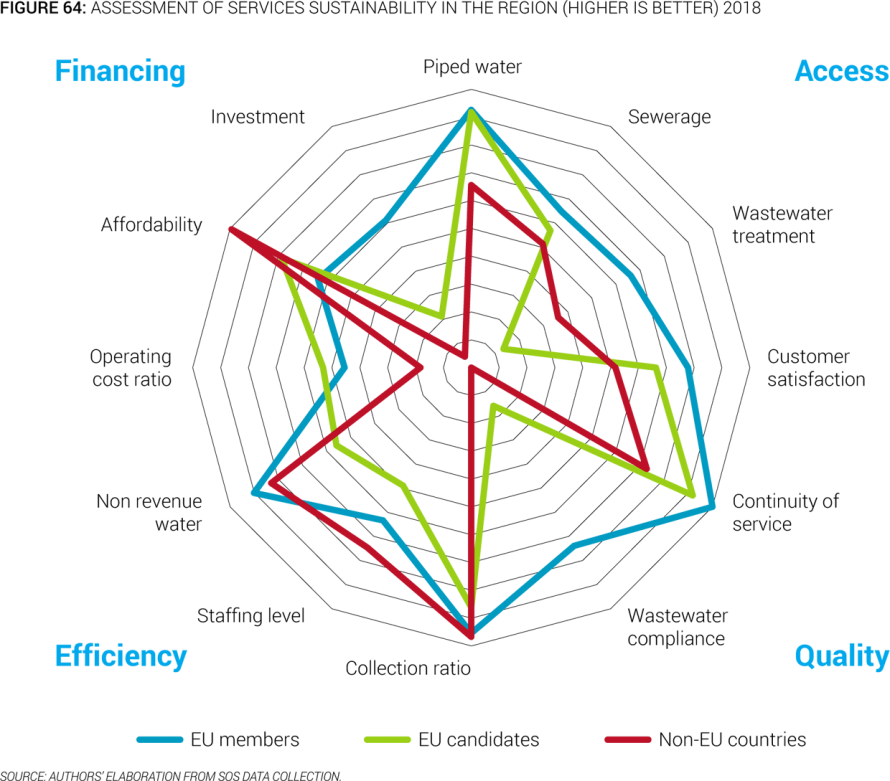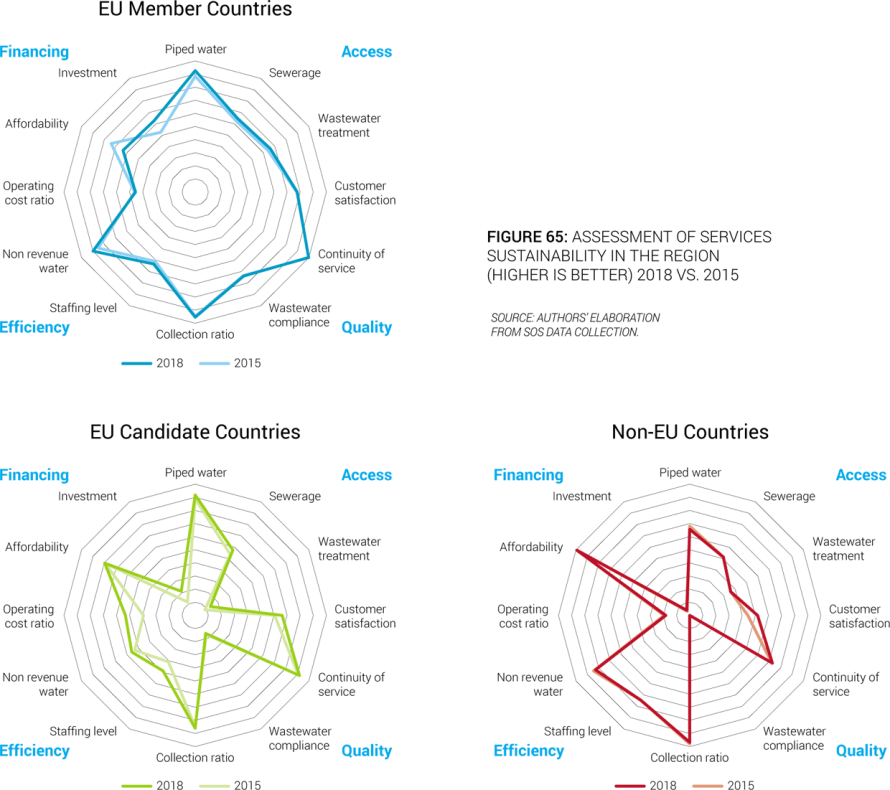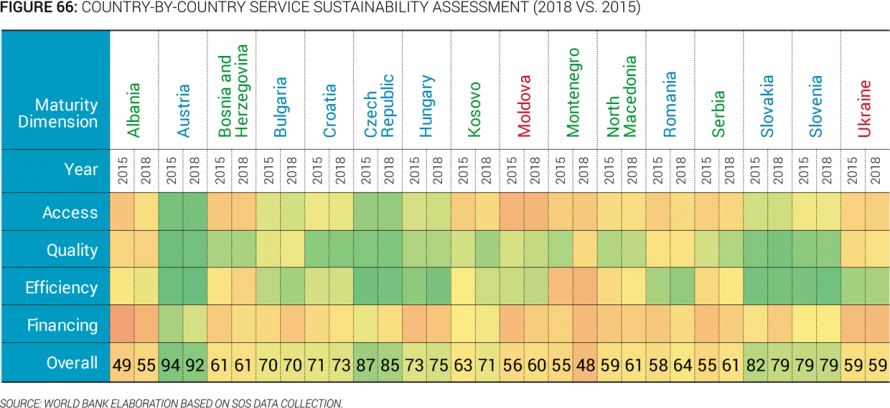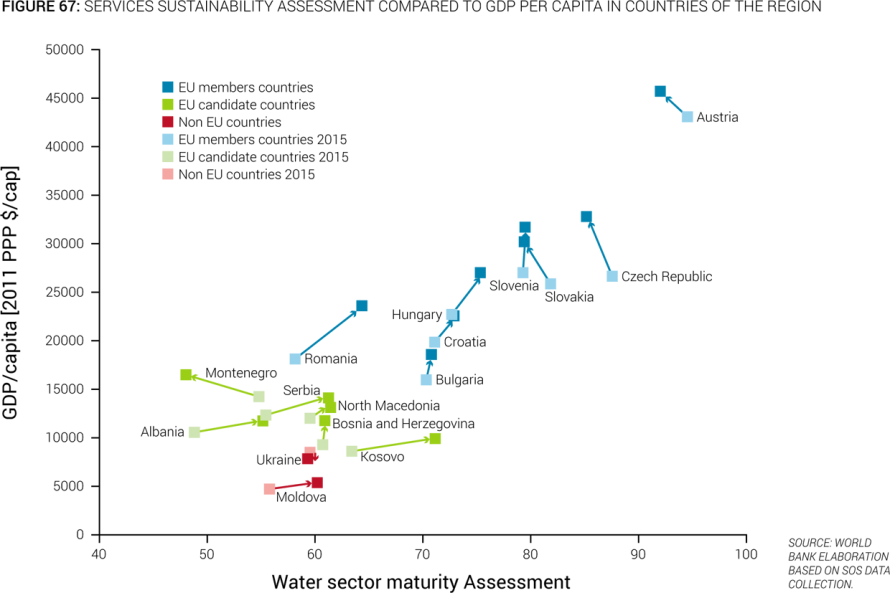A. Progress since 2015
105. The water and wastewater sector in the Danube region has moved forward since 2015, with generally positive trends in terms of expanding access, improving the quality of services and the efficiency of service providers, and increasing cost recovery and overall investments going to the sector. These trends are confirmed by the overall sustainability assessment using the WASCO methodology which looks at the basic dimensions of access to services, quality of such services, efficiency of service providers and financing of services, using latest data available from the SoS 2018 data collection exercise34. On average, all variables analyzed under each of the four dimensions have improved for the region as a whole, except for an overall deterioration of affordability levels (logical given increased in costs and tariffs), as well as compliance with the UWWTD, which has remained at 2015 levels. Figure 64 presents the updated sustainability assessment for the entire region and Figure 65 by groups of countries, showing the trends and the evolution of each group from 2015 to 2018.
106. Consistently with the overall progress noted above, the overall water sector sustainability index/score (WASCO) for the Danube region has improved by one point since 2015, (from 67 in SoS 2015 to 68 in SoS 2018). The comparison between 2015 and 2018 shows a converging trend in the region during the period between the EU and non-EU countries, with the following key trends observed by groups of countries:
- EU countries have maintained, in general, their 2015 levels in quality of service, and made further improvements in efficiency (staffing and NRW) as well as in investment levels. Affordability has however deteriorated, reflecting that, as investments and cost recovery increase, the issue of affordability emerges. Compliance with UWWTD has also stalled (most likely due to improved data and country reporting mechanisms).
- EU candidate countries have significantly progressed since 2015 in almost all dimensions, particularly access, quality of service, efficiency, and operating cost coverage, which could be attributed to different efforts by the countries and service providers to improve in these areas in recent years, and showing that, as service provider efficiency improves, cost coverage also increases. EU-candidate countries have stepped up three points (from 57 to 60) in their average WASCO index, closing part of the gap with EU countries;
- Non-EU countries have progressed overall in-service quality (mostly driven by improvements in continuity in Moldova) and customer satisfaction (in Ukraine), although they are showing a slightly decreasing trend in access to the services (in Ukraine), probably due to insufficient investment (which has also increased from 2015, but at a much slower rate than EU candidate countries). Non-EU countries have also worsened slightly on NRW levels (driven by an increase of reported NRW in Ukraine over the period). Non-EU countries are also scoring two points higher (from 58 to 60) in their WASCO index.
107. At individual level, two thirds of the countries in the region have either maintained or improved their water services sustainability assessment score, driven in each case by different dimensions (Figure 66). Although each country is at a different stage, all have areas in which they can further improve. Most countries in the region offer reasonably good service quality to those connected to public supply. Several countries are showing improvement in the quality and efficiency dimensions, especially candidate and non-EU countries. Albeit some overall improvement in the level of investment going to the sector, sound sector financing remains an issue throughout the region, with some exceptions in older EU member states. Those that have come down on their score are all from the group of EU countries (except Montenegro), showing that high levels of sustainability in all dimensions are not easy to be maintained (and that there are trade-offs between increasing investments funded by tariffs and affordability).
108. Economic development is a good predictor for the water sustainability assessment across countries, but not exclusively. As shown in Figure 67, there is a strong relationship between economic development and the WASCO scores. It is particularly noteworthy that the least developed countries would have improved, while the more developed have either improved less than their economic development, or regressed, suggesting that improvement can reach a plateau after a certain level. There are also several deviations where WASCO performance is considerably higher than the level of GDP per capita would suggest. This could be attributed to the leadership of some countries in initiating sector reforms to address political economy and structural institutional issues, whereas others, even if focused on EU compliance agenda, don’t fare so well in addressing broader sector challenges. The cases of Kosovo and Moldova also suggest that contextual factors other than economic development alone can shape the performance of a country’s water utility sector, as some countries are clearly outperforming others at similar levels of development. Kosovo’s remarkable improvement in the score is driven by a combination of increased investment in the sector (up by 17% from 2015 levels) with significant efficiency gains (reported NRW reduction of 20% and improvement in collection efficiency of 13% since 2015) which has probably also positively impacted customer satisfaction with the services (up by 14% since 2015). Montenegro’s deterioration of its WASCO score in spite of economic progress is another example, in this case mostly driven by a sharp decrease of its collection efficiency.




